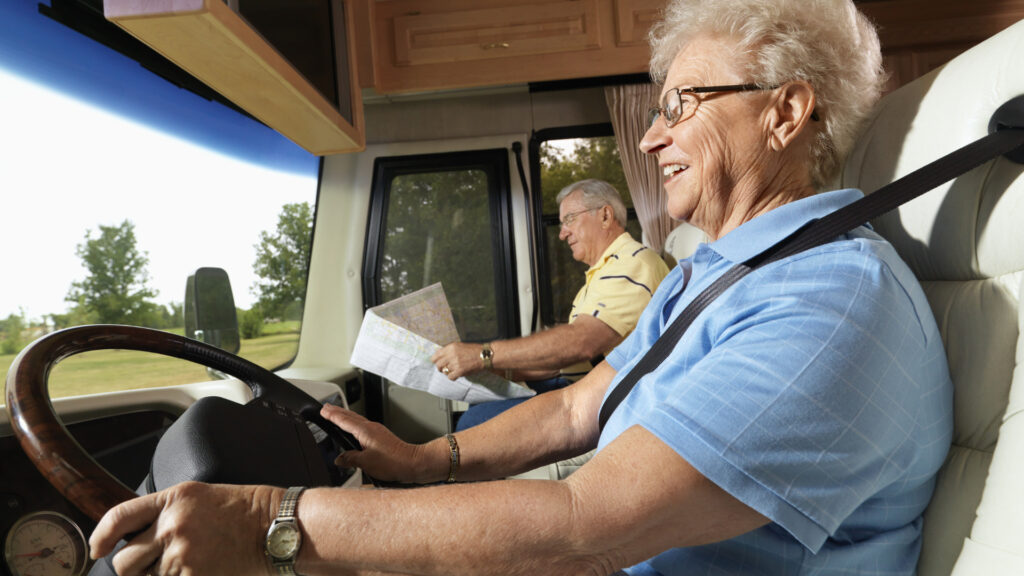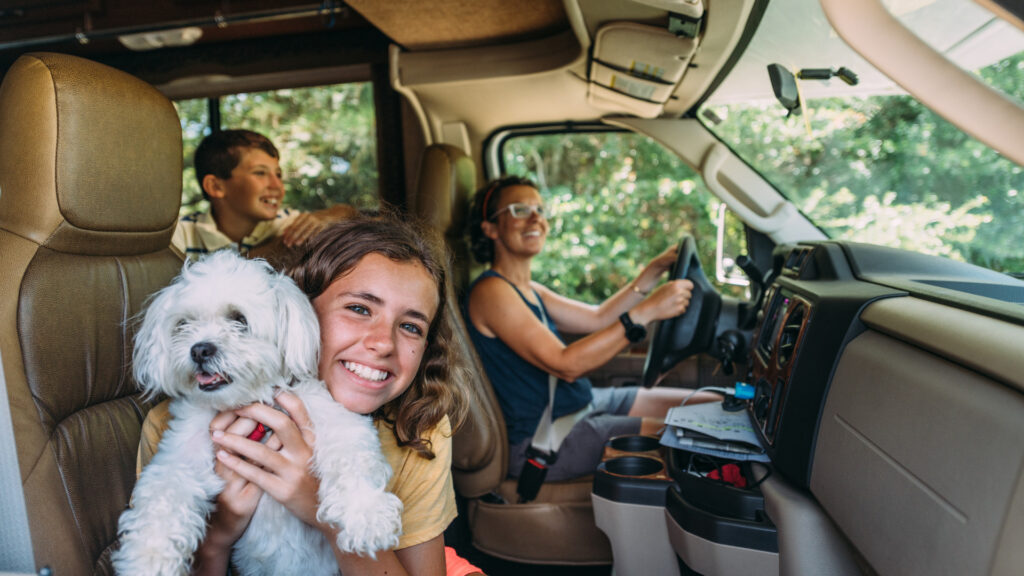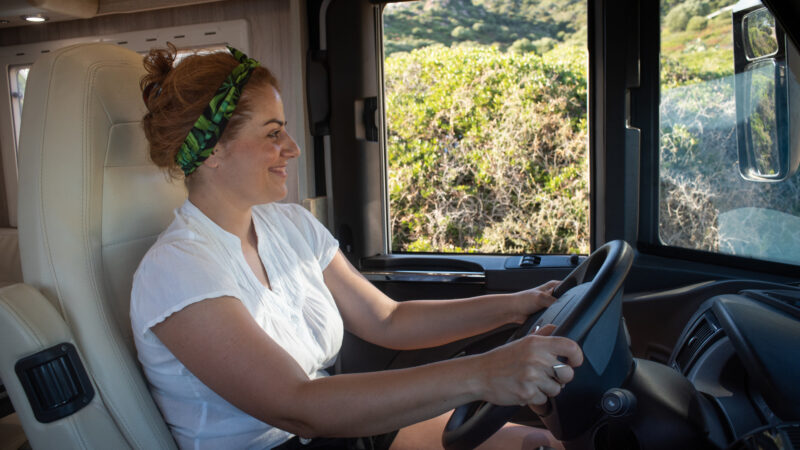Table of Contents Show
Wearing seatbelts in RVs is one of the most hotly debated topics in RVing safety. Manufacturers don’t have to follow the same strict guidelines for seatbelts in the rear of a motorhome as they do for the front cab area.
This means rear seatbelts in RVs often attach to wooden floors rather than steel or other types of metal. They can give a false sense of security. If you’re involved in an accident, RV furniture and items in cabinets can come crashing down on a rear occupant.
But this question of safety doesn’t address whether you have to actually wear a seatbelt in an RV. This is the main question for folks traveling with more than two people.
Do the passengers in the rear of the RV have to wear a seatbelt? Let’s find out.
What Are the Different Types of RVs?
Although the term RV may encompass many types, recreational vehicles have specific classes that designate a towable RV from a drivable RV. For example, towables include travel trailers, fifth wheels, pop-up campers, toy haulers, and any other type of RV pulled by another vehicle.
On the other hand, motorized RVs have engines that power themselves. Class A motorhomes are the largest and most expensive. These are the typical motorhomes many people envision when thinking about RVs.
Usually, the smaller and lighter Class C motorhomes have a truck chassis with a cabover bed. And they don’t have as large of a front windshield as a Class A.
Finally, Class Bs are camper vans that resemble a cargo van in size.
Which RVs Can You Ride in While Moving?
Although you can legally ride in a towable RV in some states, this isn’t something you should do. It’s safest for passengers to sit in the tow vehicle. This is one reason many families choose this type of RV. Their tow vehicle makes a safe place for children to ride in their car seats.
On the other hand, you can ride in motorized RVs while in motion. These have a front cab with two captain’s chairs for the driver and passenger. But others can also sit behind the cab in the RV area.
Often motorized RVs have seatbelts in the couch or dinette for additional passengers to strap in. Passengers can legally be anywhere in the RV, although that doesn’t mean they should. Always make safety a priority when traveling.

Do You Have to Wear Seatbelts in RVs?
Just as states have varying requirements for special licensing when driving RVs, they also have varying laws regarding seatbelts. It’s important to know the different laws to prevent a ticket.
All states require the two people sitting in the cab to wear a seatbelt. New Hampshire is the only state that has exceptions, but it’s best to follow this law no matter where you drive.
Regarding the passengers in the rear of the RV, state regulations vary. For example, in Alabama, people in the front must buckle up, but people in the back don’t have to.
In California, Kentucky, and Montana, everyone must buckle up no matter where they sit or how old they are.
Other states like Illinois and Arizona require passengers under age 15 to wear a seatbelt in the back of an RV.
Then other states like Florida, Georgia, and New York require children under 18 to wear a seatbelt. So no matter where you register your RV, you need to know the laws of each state.

Do Children Have to Wear Seatbelts in RVs?
Not every state requires children to wear seatbelts in RVs. As mentioned above, Alabama doesn’t require passengers in the rear of the RV to buckle up. Other states mandate that all passengers must use their seatbelts regardless of age.
Some states set the law based on age. Kansas sets it at 14, while Louisiana and Oklahoma set the age at 12. North Carolina says children under 16 must wear a seatbelt, and New Jersey says anyone 17 and under must buckle up.
Tips for Safe RV Driving With Kids
Driving with kids in a motorized RV has its challenges. Plenty of RVers debate the issue of whether or not children still in car seats can ride in the back of a motorhome.
Federal and state governments have no guidelines about this issue. The biggest problem is that most RVs don’t come equipped with the shoulder strap that many car seats require.
But aside from the car seat debate, we have some safety tips for RV driving with kids. First, remain seated. Children moving about in an RV while in motion can fall and possibly get hurt, especially while walking around. Even a Class A motorhome with the smoothest ride will feel bumps and dips in the road.
Even though seatbelt laws vary, it’s safest for everyone to buckle up. This will also help children remain seated. Some families with motorhomes have chosen to drive a second vehicle for their children to ride in.
This eliminates the temptation to get up and walk around the RV while it’s in motion. They can sit safely strapped into their car seats or buckled up correctly in the rear of the second vehicle.
Keep in Mind: These RV Safety Products will make you feel secure during your entire roadtrip!

Are There Laws About Putting Seatbelts in RVs?
No federal laws mention putting seatbelts in RVs except for the front cab. RV manufacturers must only comply with seatbelt standards for the front passengers.
These cab areas must follow the same regulations as a truck cab. But these laws don’t include specific standards for rear seatbelts.
Can You Sleep in an RV While Moving?
Again, this law varies by state. Many states prohibit sleeping in the rear of a motorhome, although you can still catch a nap in the passenger seat.
Even if a state allows this behavior, it might not be the safest or most enjoyable activity. If the RV suddenly stops, you could easily fall out of bed. It’s best to stay buckled in the front seat with a pillow and recline back.
Can You Walk Around an RV While Moving?
If the state you’re traveling through doesn’t require seatbelts for rear passengers, you can walk around in a motorized RV.
But if traveling through California or another state that enforces strict seatbelt laws, no matter where you sit or how old you are, you must remain seated with your seatbelt in an RV in full use.
If in a state like Alabama with more lax seatbelt laws, always move about carefully. Sudden stops or tight turns can easily knock you over. So only move about if necessary.
Keep in Mind: An RV is a huge purchase! Before you buy your RV, do you know if the Lemon Law applies to RVs?
Drive Safely, Obey State Laws Regarding Seatbelts in RVs
The RV lifestyle generally takes travelers from state to state. Because of this, always stay up-to-date about the seatbelt laws for each area. You don’t want to ruin a road trip with a ticket. But you also want to travel safely.
Get to your destination without any injuries or accidents by making smart, safe decisions. Wear seatbelts as much as you can and do so properly. You’ll feel safer with it on.
Do you struggle to keep up with the regulations for seatbelts in RVs?






